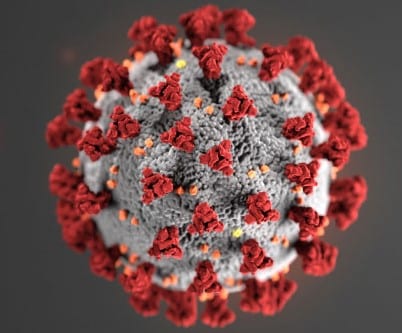
So I’ve been doing some COVID math — the sort that isn’t really good enough to put myself forth as an expert but which I want to write down, in a bloggy fashion.
It starts with this: two weeks ago, in a CNN interview, CDC director Rochelle Walensky said that for “every 20 vaccinated people, one or two of them could get a breakthrough infection.” A White House staffer said, “If 10 vaccinated people walk into a room full of COVID, about 9 of them would walk out of the room WITH NO COVID. Nine of them.” And the New York Times tweeted, based on an internal CDC report, that “The Delta variant is as contagious as chickenpox and may be spread by vaccinated people as easily as the unvaccinated, an internal C.D.C. report said.”
Shortly afterwards, I attended a school board meeting and talked to parents beforehand — specifically, skeptical parents, Polish-immigrant parents conditioned, I suspect, to distrust the political authorities — and they expressed the belief that vaccine mandates were to be distrusted because the CDC itself said that the vaccine doesn’t work. I tried to redirect their frustration — yes, the CDC’s spokespeople do a bad job and stoke fear, the entire point is that the vaccines work so we shouldn’t be locking down again, and, besides, the school board should be taking responsibility for its decisions rather than just claiming that the superintendent can do whatever he wants — but it was clear to me that they were not using the CDC messaging as an excuse for being anti-vaccine, but that they were sincere that they believed the CDC said, “you’re just as much at risk if you’ve been vaccinated as if not.”
About the studies.
Let’s start with the basic math: the Pfizer vaccine is 95% effective.
That does not mean that you have a 1 in 20 chance of getting infected if you have been Pfizer-vaxxed, let alone a 1 in 10 chance of getting infected after a single instance of exposure.
In simplest terms, it means that your risk of COVID is reduced by 95% from what it otherwise would be.
But it’s not actually that simple.
Before I get into my math (both the reasonable parts and the whoa! that’s a stretch parts), let me add that I’m asking myself what the eventual outcome of the pandemic, the variants, the vaccination rates, and so on.
Will we eventually boost our vaccination rates high enough that we can beat back the breakthrough infections once and for all, and our mistake was simply believing that a 70% vaccination prevalence was “good enough”?
Will we have to resign ourselves to everyone, vaccinated or not, getting covid, and it’s just a matter of time — but that getting vaccinated nonetheless is vitally-important for almost everyone, except, perhaps, for those at low enough risk of serious consequences from COVID that they’d prefer to take their chances?
And on the one hand, the CDC’s reaction to the Provincetown outbreak — in the midst of what is apparently called “Bear Week,” when large numbers of people engage in all sorts of risky activities — was clearly overblown, since any such statistical distribution will inevitably have outliers, but, on the other hand, well, the memory care community that my mother lives at, is in the midst of a similar outbreak — and to my knowledge, there is no available data on the likelihood of breakthrough infections among people of different ages or health statuses.
And on the third hand — well, there’s Iceland. They have “one of the highest [vaccination rates] in the world,” but they are now seeing soaring case counts attributed to the Delta mutation. As of just last week, on August 6, the country had a rolling-average case rate (32.1 per 100,000) pretty much equal to that of the US (though theirs has dropped with new mitigations imposed, and the US rate is still climbing), after having previously had such incredibly small rates that they were considered one of the prime examples of successes, with, indeed, virtually no deaths at all.
Now, to be sure, virtually none of the infected vaccinated Icelanders have been sickened to any serious degree. But it’s enough to raise concerns.
Now, the math:
The Pfizer study consisted of 46,320 participants. During the course of the trial, there were 162 infections among those who got the placebo, and 8 among those who got the real vaccine. That translates to a rate of 175 (OK, 174.9) per 100,000 for the placebo group and 8.6 per 100,000 for those with the vaccine. Divide 8.6 by 174.9 and subtract 1 and you get a 95% reduction in infection for those with the vaccine vs. the placebo group.
That’s the math.
But what does it mean?
Is your personal risk reduced by 95% if you’ve been vaccinated? I’m not really sure. The press release says that “efficacy was consistent across age, gender, race and ethnicity demographics,” and that efficacy was 94% for those over 65 years. Was it consistent across health status, barring the rare issues such as being immunocompromised, or were certain groups more likely to be infected? With only 8 infections among the vaccinated, how is it even possible to say that “efficacy was consistent”?
Similarly, for the Moderna trial, there was 28,207 participants; 185 of the placebo recipients and 11 of the vaccine recipients became infected during a follow-up period of 9 weeks after the second dose. (I couldn’t find the follow-up period duration for Pfizer). This translates to rates of 328 per 100,000, unvaxxed, for the placebo group, and 19.5 per 100,000, for the vaxxed group, for the 7 weeks from full effectiveness. Again, the math says that the risk of infection was reduced by 94%. But, again, how do you interpret this, especially over the long term?
Here’s one question which I haven’t yet seen addressed: who are the 5% (or 6%)? Are there particular categories of people who are at greater risk of a breakthrough infection (not counting, again, the immunocompromised, who the Moderna materials specifically state were excluded from the trial)? After all, in the case of birth control pills, we know that women who are obese experience lower effectiveness, as well as women who are taking antibiotics. Are there similar instances for vaccines?
(According to a Washington Post article, immuncompromised-ness is rare, affecting people with “specific blood cancers or organ transplants” and prevalent, affecting 3 – 4 million people, or 1%-ish of the population. I can’t imagine that the specific causes of immunocompromise listed in the article truly affect this many people, and that there’s both a narrow and a broad definition of the term. But, again, the Moderna trial specifically states that they were excluded, and I presume that was the case for Pfizer as well. Oh, and that same article said that people over 65 generally get a higher-dose flu shot because they produce fewer antibodies, but the Pfizer info specifically says that oldsters were well-protected.)
In any case, it would be reasonable, if there were certain types of people who would be less protected, for this information to be made available to people. Is this another “noble lie,” and the CDC has decided that “for their own good,” people can’t be told this?
Or is it simply the case that, by and large, the breakthrough infections are caused by “superspreaders” — a level of infectiousness so substantial that it pushes past the vaccine, and that the reason why the vaccine is so effective nonetheless is that this level of infectiousness is fairly rare? This seems to be the case from the available reporting, though it’s poorly reported on, for example in a New York Times article that promises to explain “Why Vaccinated People Are Getting ‘Breakthrough’ Infections,” but, honestly, doesn’t really do so.
In any case, having said that, what is striking about the two trials is, honestly, how few infections there were in the placebo group.
Again, in the Pfizer group, unless my math is wrong, there were 175 infections per 100,000 people, for the entire duration of the study.
In the Moderna group, there were 328 infections per 100,000 people.
Why these rates would be different for the two groups is not entirely clear to me. The Moderna materials, again, state that they measured infections for a period of 7 weeks following the “fully vaccinated” date. I don’t see anything in the Pfizer materials that specifies this; I have the impression, instead, that the study ended when they deemed the data to be sufficient. (Maybe that was also true for the Moderna trial – that is, that the 7 weeks was not predetermined?) So perhaps it’s as simple as the Moderna study, which had only 3/5ths as many participants, needed to run longer to collect the necessary data. On the other hand, it may also be possible that the parts of the country or the other countries that Moderna recruited study participants in, had a spike in cases that didn’t occur in the Pfizer regions.
In any case, again, consider that at the moment, Florida’s daily per 100,000 case count stands at 89.6. That’s according to the Financial Times covid tracker. What’s more, in Florida, half the population (49.4%) is fully vaccinated. On the basis that a vaccinated person has a 95% reduced risk of infection, I did a little bit of math (again, my math could be wrong) to calculate that, adjusted for vaccine protection, Florida now has a baseline infection rate of 169 per 100,000 per day.
Yes, my math says that the number of infections occurring per day in Florida is equal to the number of infections (for the placebo group) that occurred for the entire course of the trial, for the Pfizer group.
Or, to take a smaller example, the current rate in Illinois is 18.9 per 100,000. The vaccination rate is nearly identical to that of Florida (yeah, I know, Florida’s high case rate is being blamed on the low vaccination numbers but that doesn’t seem to match up with the data itself, per the New York Times). Doing more math says that with a vaccination-protection-adjusted rate of 35.4, Illinois has as many infections in 5 days and the Pfizer study did over its entire duration.
Let’s do some more bad math:
Let’s assume that the category of immunocompromised people are statistically irrelevant, because there’s no real way to factor them into the story.
Then let’s define an “exposure period” as “the length of time, under a given set of conditions, it takes for there to be 175 new infections per 100,000 for an unvaccinated group.” And let’s say that, for any given “exposure period,” a given person has a 0.175% probability of becoming infected, if not vaccinated or, if vaccinated, 5% of that risk, or 0.0087%. This translates into a 99.825% risk of remaining uninfected in the first case, or 99.9913% in the second.
But if getting infected is mostly a matter of bad luck, rather than a personally-elevated risk, then the risk of being infected in any given “exposure period” is independent from any other one, and the risk of remaining uninfected is calculated in an exponential manner: for example, for five periods, the probability of remaining uninfected is 99.825% x 99.825% x 99.825% x 99.825% x 99.825% (or 99.9913% x 99.9913% x 99.9913% x 99.9913% x 99.9913% for the vaccinated case).
And, still, as long as the “exposure periods” remain fairly low, because we determine that each such period of time is fairly substantial, the overall probability of remaining uninfected is still fairly high, and the risk of becoming infected is small. But if you consider that, in Florida, an unvaccinated person has just as much likelihood of being infected in a single day, as was the case for the entire duration of the Pfizer trial, could we say that an “exposure period” is simply a day, and that the risk compounds so quickly that over the course of a year, an unvaccinated person has a 50-50 chance of getting covid? In that scenario, a vaccinated person would have a 3% chance of becoming infected over the same timeframe. This illustrates the combination of the effectiveness of the vaccine and the low prevalence of covid overall.
But let’s cook up some more scenarios. We’re being told that new variants are far more infectious. What if a new variant were twice as infectious? My Bad Math says that over a year’s time, an unvaccinated person would have a 72% chance of becoming infected, and a vaccinated person, a 6% chance. (Yes, that’s the math of compounding.) You really have to push the numbers a fair bit to get significantly-elevated risks of covid for a vaccinated person — for example, a virus that’s 10 times as virulent, over 2 years, would produce that same 50-50 chance for infection for a vaccinated person, was we previously had for an unvaccinated person over one year.
But what if the vaccine becomes less effective against a new variant? At 90% effectiveness, our 3% one-year “vaccination failure rate” becomes 6%. At 80%, it’s 12%. And so on.
What about “herd immunity”?
So the first thing to note is that my calculations were based on a hypothetical that the only people with reduced risk of infection were the vaccinated. Obviously, a fair share of the population, in addition to the vaccinated, have already been infected.
So the first thing to note is that this means that our “adjusted infection rate among the fully-exposed” increases significantly. If we use a 65% “vaccinated/immune” rate, then that boosts the infection rate among the full-exposed to 234 in Florida, or a 33% increase, and means that the “exposure period” is 75% of a day. So this means that the 50-50 probability of being infected is that of a 9 month period; for a full year, that rate climbs to a 57% chance of infection for the non-protected, and 4.2% for the protected.
At the same time, yes, the cumulative effect of each person who becomes sick meaning that they won’t get sick and expose others later, does make a difference. But when I take the same calculation, and adjust the risk of infection to reflect the decreases due to previously-infected people reducing by some small fraction, that initial probability of infection — well, there’s not that much of a difference, really.
After a year (365 “exposure periods”), the unvaccinated have a 39% probability of having gotten covid, instead of a 47% chance. The vaccinated, a 3.09% chance rather than a 3.14% chance. But recall that my adjustments are that, taking into account the previously-sickened, we have to assume that the prevalence of infection among the not-protected population increases; and then, well, it’s a wash.
Now, again, my math is shaky. The biggest issue is whether, even without being in a category of “immunocompromised,” some people are more or less likely to be infected, even given the same level of exposure. This means that each “exposure period” is not independent (in the statistical use of the term) and all of the above math falls apart. But this, in turn, suggests that if, for whatever reason, you are more susceptible to covid than the average person (not severity of infection but exposure to a person to a given degree of closeness and infectiousness), these numbers will understate your risk and that if not, these numbers overstate your risk.
But, as a final bit of math: how does this affect effectiveness, not just infection rates? 3.1/39 – 1 = a 92% reduction. We can calculate a likelihood of getting infected, in an absolute sense, but the ultimate effect of the compounding is still fairly small.
A comparison to chickenpox.
Remember chicken pox? A childhood disease, a rite of passage. It was inevitable that you’d get it, so some moms had chicken pox parties for their kids if someone they knew had chicken pox and if it was a convenient time for a kid (or all kids in the household) to be sick, both in terms of family activities (no upcoming vacations) or because chicken pox is milder for elementary school kids than teens or adults.
A vaccine first became available in 1996, though there were questions about just how necessary a wide vaccination program was because serious cases were so rare, and it was mostly a matter of kids being sick inconveniencing parents. It took a decade for the vaccine to be officially recommended, which in turn meant that the vaccination rates for children grew slowly, from about 15% in 1996 to 40% in 1997, 65% in 1998, then increasing more gradually to 85% in 2000 and 90%-ish thereafter. (This is from a graph, eyeballing the percentages, for a specific geographical area.) How long did it take “herd immunity” to develop? That is, how soon were infants, too young to be vaccinated, well-protected? In 1995, 1.6% of infants got chicken pox; in 1998, when vaccination was at a rate of 65%, that infection rate dropped by half. Only in 2002, when we’re at rates of 85% or more, did the rate of chicken pox among babies settle in at the low rate of 0.2% that held true, more or less, for the rest of this study’s data.
Now, to be sure, it’s not clear whether, once the toddlers began to be vaccinated, the vaccine was likewise offered to older children who hadn’t yet gotten chicken pox, so it’s not clear whether this data over- or understates the prevalence of the vaccine. It’s just an interesting comparison. Does this show a speedy decline in prevalence, or a slow one? It depends on expectations.
Repeating the above, with delta effectiveness.
Reports suggest that the Pfizer vaccine is only about 80% effective against delta. So let’s redo the final numbers once more: instead of a 3% chance of infection after a year-sort-of, you have an 11% chance.
Back to Iceland.
Why is Iceland’s case rate so high? In the first place, they very recently relaxed their requirements for visitors — the explosion in case rates began on July 20th (or so; my data source is a chart so it’s hard to say exactly). Is this due to the elimination of travel restrictions as of July 1st? (Strictly speaking, these were relaxed, not eliminated — there was still a requirement to have been vaccinated.) There’s nothing in the data that suggests this. For that matter, there’s not really anything in the way of analysis as to the cause of the outbreak, though it appears that the Janssen vaccine, which was used for 21% of those vaccinated, is not as effective against the Delta variant, given that there is a proposal to re-vaccinate this group. (This is apparently their term for the J&J vaccine, which is 67% effective against Delta according to a study.)
Your mileage may vary.
Again, to repeat my math:
For the vaccine to be 95% effective does not mean that you have a 1 in 20 chance of getting sick. It means that your chances of getting infected are 95% less than an unvaccinated person, over a specific length of time — or, rather, that under the study conditions of relatively low prevalence rates and short time periods, the chances of infection for the study group were reduced by 95%.
How this plays out in the real world, over longer time periods and with different underlying covid prevalence rates, can differ substantially, when you look at your actual chances of getting infected, rather than the reduction in the likelihood of infection.
On any given day, your risk of getting covid is small, with or without a vaccination. But at the high rates of prevalence we’re seeing in Florida right now (and could see in the fall, in the North, when people stay in their houses now, as much as people in the South do in the summer), mean that over time, your risk of infection grows: to a Bad Math risk of 50:50 if unvaccinated, but still only less than 5% if vaccinated, or 11% under “delta” conditions.
One obvious bottom line is that statements like “herd immunity at 70%” was nonsense — and that the feds, and community groups need to do a better job of marketing the vaccine, not as your civic duty but “your chance of a side effect is X, and you’re worried about that, and we get it, but your chance of a serious effect from covid is worse” — with actual numbers.
But I was hoping that in working through these numbers and reading the links, I would acquire some insight into what the government should be doing in the meantime, with respect to precautions against breakthrough infections, which currently affect my family in two ways: first, my son is required to wear a face mask all day for a second year, with no known information on how much of a difference it really makes to kids who have been vaxxed; and, second, the memory care community mom lives at, has just had an outbreak, and I’m asking myself, statistically, does this mean that we’re in trouble, and, beyond that, what are the appropriate level of precautions to take, even with everyone vaccinated?
So I’m going to click publish and walk away from this, and apologize for the 3,000 word length here, and move on to something else (Illinois pensions, anyone?). Sigh.













